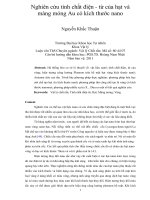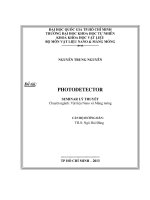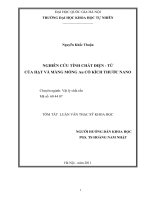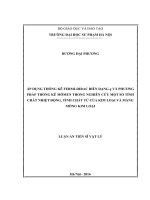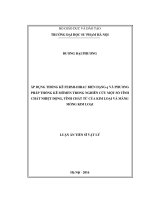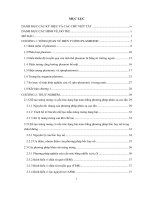Slide nano và màng mỏng fabrication of nano systems
Bạn đang xem bản rút gọn của tài liệu. Xem và tải ngay bản đầy đủ của tài liệu tại đây (2.33 MB, 66 trang )
.c
om
PART III: Fabrication of Nano Systems
co
ng
1. Deposition
th
an
2. Lithography
du
o
ng
3. Etching
cu
u
4. Interconnects
1
CuuDuongThanCong.com
/>
.c
om
1. Deposition Technology
A. Physical Vapor Deposition (PVD)
th
an
co
ng
- Introduction to Sputtering
- Various Sputtering Techniques
ng
B. Chemical Vapor Deposition (CVD)
cu
u
du
o
- Introduction to CVD
- Various CVD Equipment and Techniques
2
CuuDuongThanCong.com
/>
INTRODUCTION TO PVD
.c
om
• PVD is a process to form a non-volatile solid film on the
substrate by physical methods.
ng
• PVD is mainly used for metallization in Si IC applications.
co
• Mainly, three PVD methods exist
th
an
– Evaporation (Thermal and e-beam)
ng
– Sputtering (Glow discharge)
du
o
– Pulsed laser deposition (laser ablation)
cu
u
• Very seldom used in Si IC, we will not discuss this
technique
3
CuuDuongThanCong.com
/>
EVAPORATION (BASIC OPERATION)
Wafers are loaded into a high
vacuum chamber that is commonly
pumped already
•
The charge or material to be
deposited is loaded into a heated
container called the crucible. It can
be heated by means of an
embedded resistance heater and an
external power supply.
an
co
ng
.c
om
•
As the material in the crucible
becomes hot, the charge gives off a
vapor.
•
Since the pressure in the chamber
is very low, the atoms of vapor
travel across the chamber in a
straight line until they strike a
surface where they accumulate as a
film.
cu
u
du
o
ng
th
•
4
CuuDuongThanCong.com
/>
EVAPORATION (PHASE DIAGRAMS)
Sublimation and Evaporation
th
an
co
ng
•
Vapor pressure is a very strong
function of temperature
Normally, a partial of about 1-10 mT
or more is required to achieve
reasonable deposition rates (on the
order of 0.1-1 um per minute), and
one can see that about 1100oC is
needed for the evaporation of Al.
This means that the Al is evaporated
from the liquid phase.
When the material is evaporated
from the liquid phase, the vapor
pressure can be given as
.c
om
•
du
o
ng
•
cu
u
Sublimation: vapor is from solid
Evaporation: vapor is from liquid
Normally, evaporation provides
higher vapor pressure and hence
higher deposition rate
5
CuuDuongThanCong.com
/>
EVAPORATION (DEPOSITION RATES)
The mass loss rate of the crucible can be calculated as
•
Two approximations:
– If the charge is completely molten it is common to assume that
natural convection and thermal conduction will keep the
temperature of the charge nearly constant across the crucible
– It is also assumed that the opening of the crucible has a
constant area, A
cu
u
du
o
ng
th
an
co
ng
.c
om
•
6
CuuDuongThanCong.com
/>
EVAPORATION (DEPOSITION RATES)
To find the deposition rate on the
surface of a wafer, the fraction of
the material leaving the crucible
that accumulates on the surface of
the wafer must be determined.
•
Material ejected from the crucible
travels in a straight path to the
wafer surface due to low pressure.
an
co
ng
.c
om
•
Assuming that all of the material
that arrives at the wafer sticks and
remains there, the arrival rate then
is governed by simple geometry.
•
Thus, the constant of proportionality
is just the fraction of the total solid
angle subtended by the wafer as
seen from the substrate.
cu
u
du
o
ng
th
•
7
CuuDuongThanCong.com
/>
.c
om
EVAPORATION (DEPOSITION RATES)
• The proportionality constant is given by
•
du
o
an
th
ng
•
•
co
ng
•
Deposition rate depends on the location
and orientation of the wafer in the chamber
Wafers directly above the crucible will be
coated more heavily than wafers off to the
side
Film uniformity is also a concern
One method to obtain good uniformity is to
place the crucible and wafers on the surface
R
of a sphere. Then
cosθ = cosφ =
cu
u
1st term: depends on material
2nd term: depends on temperature
3rd term: depends on geometry of
the chamber
•
2r
The deposition rate is the mass arrival per
unit area divided by the mass density of the
film
8
CuuDuongThanCong.com
/>
EVAPORATION (STEP COVERAGE)
.c
om
Two methods to improve step
coverage:
ng
(1)To rotate the wafer substrates
cu
u
du
o
ng
th
an
co
(2)To heat the wafer substrate
9
CuuDuongThanCong.com
/>
cu
u
du
o
ng
th
an
co
ng
.c
om
INTRODUCTION TO PVD (SPUTTERING EQUIPMENT)
10
CuuDuongThanCong.com
/>
SPUTTERING (RF SPUTTER DEPOSITION)
•
DC sputter deposition is not suitable for insulator deposition
.c
om
– A problem with applying the necessary DC voltage to the
insulating target to initiate a plasma
The solution is to use RF, instead of DC. 13.56MHz RF power
co
•
ng
– Other major difficulties arise, such as particle issue
th
RF voltages can be coupled capacitively through the insulating
ng
•
an
source is commonly used.
The RF frequency is chosen to be high enough so that a
cu
•
u
necessary
du
o
target to the plasma, so that conducting electrodes are not
continuous plasma discharge is maintained.
11
CuuDuongThanCong.com
/>
SPUTTERING (BIAS SPUTTERING)
•
Sometimes sputtering of wafer is desirable for
.c
om
– Precleaning the wafer before actual deposition
– Bias sputtering, where deposition and sputtering are done simultaneously
A negative bias relative to the plasma is applied to the wafer electrode, which
is now electrically isolated from the chamber walls.
•
Positive Ar ions from the plasma will now be accelerated to the wafers on the
substrate and sputter off the atoms.
•
Usually an RF bias is used since the wafers often have insulating films on
them.
•
In sputter etching or cleaning, no deposition is allowed to occur on the wafer
by using a shutter to block sputtered material from the target.
du
o
ng
th
an
co
ng
•
cu
u
– During this step, a controlled thickness of surface material is sputtered off
the wafer, removing any contamination or native oxide
– A film can then be sputtered immediately afterward without breaking the
vacuum
12
CuuDuongThanCong.com
/>
SPUTTERING (FUNDAMENTAL)
Positive ions in the plasma are accelerated to the negatively biased target
(hundreds of volts to thousands of volts)
•
Energetic ions strike the target and dislodge or sputter the target atoms
•
These atoms then travel freely through the plasma as vapor and strike the
surface of the substrates, where they condense to form the deposited film
•
Note: since the targets acts as an electrode in the DC mode of sputter
deposition, the target must be conductive.
Target
du
o
u
Positive ion
(Ar+)
Positive(+)
cu
Substrate
ng
th
an
co
ng
.c
om
•
Negative(-)
13
CuuDuongThanCong.com
/>
SPUTTERING (DEPOSITION RATE)
Sputter yield (S) is the ratio of the number of
target atoms ejected from the target to the
number of ions incident on the target.
•
Sputter yield depends on ion mass, ion
energy, target mass and target crystallinity.
•
Sputter yield is proportional to energy of
incident ion (E) but inversely proportional to
surface binding energy (U0)
du
o
ng
th
an
co
ng
.c
om
•
cu
u
•
S∝
4mt mion
E
(mt + mion ) 2 U 0
For ion energy larger than threshold energy,
sputter yield tends to increase as the square
of the energy up to about 100eV, then linearly
with energy. Above ~1000eV, yield increases
only slightly until the onset of implantation.
14
CuuDuongThanCong.com
/>
SPUTTERING (STEP COVERAGE)
Sputter has worse step coverage
than CVD
du
o
ng
th
an
co
ng
.c
om
•
Heating substrate can improve dramatically the step coverage due
to surface diffusion
•
A second technique for improving the step coverage is to apply
an RF bias to wafers. (will discuss later)
cu
u
•
15
CuuDuongThanCong.com
/>
SPUTTERING (MAGNETRON SPUTTER DEPOSITION)
In both conventional DC and RF sputtering, efficiency of ionization from
energetic collision between electrons and gas atoms is rather low
•
In magnetron sputtering, magnets are used to increase the percentage of
electrons that take part in ionization events, and the ionization efficiency is
increased significantly (about 10-100 times higher)
•
A magnetic field is applied at right angle to the electric field, usually by placing
large rectangular magnets behind the target.
cu
u
du
o
ng
th
an
co
ng
.c
om
•
16
CuuDuongThanCong.com
/>
INTRODUCTION TO CVD
.c
om
- CVD is a process to form a non-volatile solid film on the substrate by
reaction of vapor phase chemicals.
ng
- Energy for reaction is supplied by thermal methods, photons or
th
an
co
electrons.
ng
In microelectronics manufacturing, polycrystalline Si (called Poly-Si),
du
o
dielectric materials such as silicon dioxide (SiO2) and silicon nitride (Si3N4),
interconnect / contact plug such as tungsten (W), silicide materials such as
CVD techniques.
cu
u
tungsten silicide (WSi6), and diffusion barriers (Ti/TiN) are deposited by
17
CuuDuongThanCong.com
/>
INTRODUCTION TO CVD
.c
om
Advantages of CVD processes
over other competing techniques
ng
– Wide variety of chemical
co
compositions
an
– High deposition rates with
ng
– Low manufacturing cost
th
good step coverage
du
o
– Only one stage (LPCVD) or
u
no pumping (APCVD)
processes are possible
cu
•
18
CuuDuongThanCong.com
/>
INTRODUCTION TO CVD
•
Desired characteristics of CVD films are
– Good thickness uniformity
.c
om
– High purity and density
– Controlled composition and stoichiometry
ng
– High degree of structural perfection
co
– Good adhesion
th
an
– Good step coverage*
ng
* Aspect ratio (AR) of a feature (AR = height of feature/width of feature = h/w)
du
o
Ỉ A parameter that can reflect filling and bottom coverage
Ỉ The feature could be a metal line or a spacer
cu
u
such as a gap between metal lines.
Ỉ A deep and narrow contact hole would have a large aspect ratio
and would be harder to fill.
19
CuuDuongThanCong.com
/>
INTRODUCTION TO CVD
.c
om
1) Transport of reactants by forced
convection to deposition region.
co
ng
2) Mass transfer of reactants by diffusion
from the main gas stream through the
boundary layer to the wafer surface.
th
an
3) Adsorption of reactants on the wafer
surface.
cu
u
du
o
ng
4) Surface processes, including chemical decomposition or reaction, surface
migration to attachment sites, site incorporation and other surface reactions.
5) Desorption of byproducts from the surface
6) Transport of byproducts by diffusion through the boundary layer and back to
the main gas stream
7) Transport of byproducts by forced convection away from deposition region.
20
CuuDuongThanCong.com
/>
VARIOUS CVD FILMS (SILICON DIOXIDE DEPOSITION)
• SiO2 is a widely used material for insulation in
.c
om
microelectronic fabrication, for example,
ng
– Isolation between cells
co
– Hard masking
th
an
– Insulation between poly-silicon and metals, and passivation.
ng
• Requirements of deposited films:
du
o
– Uniform thickness and composition
cu
u
– Good adhesion to the substrate
– High stress resistance
– Good step coverage
21
CuuDuongThanCong.com
/>
VARIOUS CVD FILMS (PECVD)
Plasma-Enhanced Deposition (PECVD)
PECVD uses a rf power to generate a glow discharge to transfer energy to
.c
om
•
the reactant gases
Deposition can be achieved at a lower temperature compared to APCVD or
ng
•
Desired properties, such as good adhesion, low pinhole density, good step
an
•
co
LPCVD
th
coverage, adequate electrical properties, have made PECVD films useful in
ng
ULSI circuits.
PECVD silicon nitride is commonly used as the final passivation layer
•
PECVD silicon oxide can be used as insulators between the metal layers
•
PECVD amorphous silicon has been widely used in TFT LCD area
cu
u
du
o
•
22
CuuDuongThanCong.com
/>
Use of RF-induced plasma to supply energy into reactant gases
Plasmas are highly ionized gases
With additional energy from the plasma to the reactant gases, deposition can
occur at lower temperatures
23
cu
•
•
•
u
du
o
ng
th
an
co
ng
.c
om
VARIOUS CVD FILMS (PECVD EQUIPMENT)
CuuDuongThanCong.com
/>
Plasma-Enhanced Deposition (PECVD)
• Deposition Methods and Variables
cu
u
du
o
ng
th
an
co
ng
.c
om
– PECVD requires
• control and optimization of rf power density, frequency and
duty cycle
• Gas composition, flow rate, temperature, pressure etc.
– PECVD process is a surface-reaction limited process
– PECVD silicon oxide
SiH4 + O2 Ỉ SiO2 + 2H2
SiH4 + 4N2O Ỉ SiO2 + 4N2 + 2H2O
– PECVD silicon nitride
SiH4 + NH3 Ỉ SiN:H + 3H2O
SiH4 + N2 Ỉ 2SiN:H + 3H2
– PECVD amorphous silicon
SiH4 Ỉ Si + 2H2
24
CuuDuongThanCong.com
/>
.c
om
2. Lithography Technology
ng
A. INTRODUCTION
co
B. PHOTORESIST PROPERTIES
ng
th
an
- PHOTORESIST PROCESSING
- PHOTORESIST MATERIAL PARAMETERS
du
o
C. OPTICAL LITHOGRAPHY
cu
u
- KEY PARAMETERS
- OPTICAL SOURCES AND PRINTING METHODS
- MASKS
25
CuuDuongThanCong.com
/>
